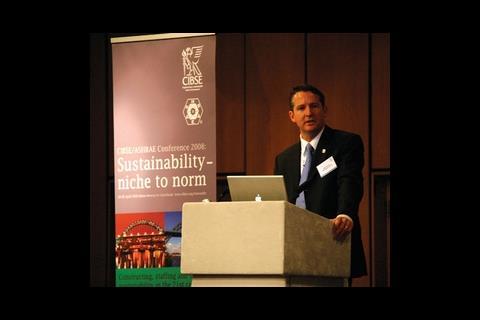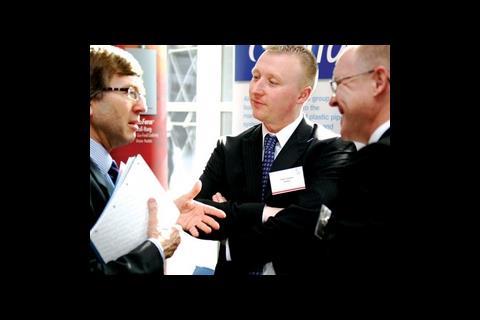The CIBSE/ASHRAE conference gave delegates an overview of progress on sustainability in construction, both in the UK and the US
“High-performance buildings are quickly becoming the norm,” Kent Peterson, president of ASHRAE, said in his presentation on the opening day of the CIBSE/ASHRAE Conference 2008, held in Gateshead. Peterson was talking about the sustainability trend gathering pace in America, and his topic mirrored the conference theme of “Sustainability – niche to norm”.
Peterson’s agenda was to highlight to the mainly UK-based audience just how far America has come in terms of green construction and to “dispel some of the myths about what is happening in the US”. He was keen to point out that the push for sustainability was happening at regional level, “in states and provinces”, rather than at a national level.
“It is obvious in the US that action is needed – and that action is coming from the bottom up,” he said. As a result of such pressure, “nearly half of Americans are living in areas covered by climate change agreements”. However, this situation was changing as energy was fast becoming a national issue in America. The Energy Independence and Security Act 2007 requires all government buildings to be net zero energy by 2030.
Ted King, principal mechanical and electrical engineer at the Department of Communities and Local Government, brought the focus back to the UK with an update on certification and legislative initiatives. He explained that one of the most significant government changes afoot concerned the Merton Rule and renewable energy generation.
King said the government was looking for local authorities to change tack on the provisions for dealing with climate change issues, and in particular the application of the Merton Rule, to enable off-site renewables to be included in the compliance. “The Merton Plus Rule would mean that renewables need not be on a building but in the neighbourhood,” he told delegates.
King added that the government was “intending to consult” on widening the application of display energy certificates to include private-sector buildings occupied by commercial organisations where large numbers of the public visit regularly, and that such an extension would be subject to separate legislation.
By the second day of the conference, the agenda had shifted more to detail design issues. Margaret Horne, director of the School of the Built Environment Visualisation Centre at Northumbria University, continued the coming of age theme from day one – only this time it was regarding computer modelling in particular rather than sustainability in general.
Mike Malina, principal and founder of Energy Solutions Associates, made a plea for greater energy monitoring to discover what was truly happening with services design. He suggested a public “name-and-shame” list that would contain, for example, buildings whose lights were left on throughout the night. Services engineers should be more involved with those who used their designs, particularly maintenance teams, to ensure they used equipment most efficiently, he said.
In a presentation titled Beyond the Buildings, Arup associate Andy Mace suggested engineers consider wider issues of design and energy. They should have a say on matters such as where eco-cites were sited and what sort of land was used, he said. It made no sense to have a new energy-efficient town miles from where people worked, forcing them to drive or to use public transport.
Sustainability goes beyond the immediate future, emphasised Dan Epstein, head of sustainable development and regeneration for the Olympic Delivery Authority. He presented a view of long-term energy planning for the 2012 Games, which includes an energy centre to supply the local community after the event finishes. The centre will have biomass boilers using woodchip waste and gas fuels and a combined cooling heat and power plant to generate domestic hot water for homes as well as to heat the Olympic swimming pool and other Games buildings. The development is on target to obtain 20% of its energy from renewable sources, Epstein told delegates.
Despite all the talk by FMs about how they could and should improve sustainability, there is still confusion over who owns the role of head of sustainability in an organisation. This made it difficult for building services firms interested in forging co-operation, said Sunil Shah, head of sustainability at Jacobs. “Who do they talk to? Is it HR, FM or finance, or do we need a separate sustainability manager?”
Shah said FMs had to step up to the plate because only they had cross-functional access to people as well as information about buildings’ performance. FMs should work with services engineers, but he warned against quick wins from short-term contracts up to three years. Sustainability was a strategy and as such should be long term, stretching up to 10 or even 15 years, he said. This allowed landlords to recoup the cost of new services systems as well as giving services firms sufficient time to monitor and develop increasingly efficient systems based on long-term occupier use.
The clear message running through the CIBSE/ASHRAE conference was that development of sustainable technologies and efficient building services were reliant on receiving solid data from occupiers about how systems operated, and were operated. John Armstrong, the outgoing CIBSE president, urged more dialogue between building services designers and those who maintained the systems, specifically facilities managers.
Young engineers go to work on a networking breakfast
It was the building services equivalent of Lord Kitchener’s “Your Country Needs You!” – the sector needs the younger generation to work with older engineers to keep them on their toes.
That was the theme of a talk by Steve Nicholson, principal of Delta Energy, to about 40 delegates at the conference’s early morning young engineers session.
“Youth is the bridge between the new and the old. Young people bring fresh thinking from their education and can couple this with what is proven in practice. They bring enthusiasm and a desire for things to change,” Nicholson told the meeting.
He urged young people not to be afraid of making their presence felt at work. Their lack of practical experience was not a barrier to participation and they must not remain in the background, Nicholson said. A perfect way to start was to get involved in an integrated design team.
Despite years of talking about young engineers’ usefulness, the sector still failed to use them as much as it should. Newer recruits should push for the creation of integrated teams because that was where the interaction of old heads and young heads produced innovation. It would mean compromise but the reward for team effort was that the whole was greater than the sum of the parts.
“It may sound obvious,” a female engineer in her mid-20s said, “but sometimes it doesn’t feel that way. It’s nice to hear someone say it.”
Source
Building Sustainable Design

























No comments yet